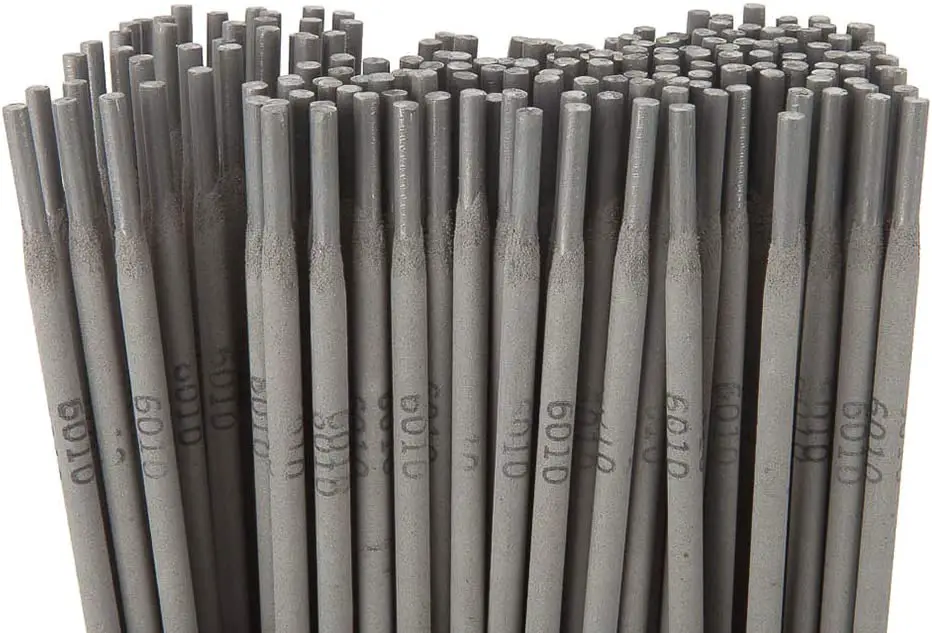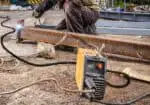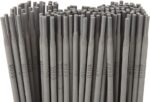Various aspects must be considered during welding rod selection as the welding rod must meet the mechanical qualities and chemical composition of the base metal, as well as joint geometry, welding position, cost, and operating condition.
And although there are hundreds of shielded metal arc welding (SMAW) electrodes available, the most often used electrodes are E6010, E6011, E6012, E6013, E7018, and E7024.
Today in this article, we are going to learn about 6010 welding rods.
Because the 6010 welding rod deposits molten metal that solidifies quickly, it is classified as a fast freezing electrode. A weld puddle that soaks up water yet cools fast. This rapid freezing property makes E6010 electrodes ideal for overhead welding.
E6010 electrodes are preferred by operators because the molten metal remains in the joint and does not fall down on them as much as other all-position electrodes.
What are E6010 Rods and its Benefits?
Stick welding rod E6010 is cellulose-coated. According to CSA W48, the electrode specifications are AWS A5.1 & E4310. E6010 is primarily utilised for pipeline welding root weld operations since it produces zero or little slag.
As a result, cleansing root run requires little work. Another reason is the E6010 rod’s high force arc, which provides full penetration while welding the root run. The main stick welding rod used for new welding trainees is E6010, followed by welding training using E7018 kinds.
Deep penetrating, high power, spray arc, and readily removed, extremely thin to insignificant friable welding slag characterise E6010 electrodes. In a visual inspection, the slag does not appear to be totally visible on the weld bead.
Because the cellulose used to make the E6010 rod is an organic substance that requires moisture, it is the source of hydrogen in the welding.
Hydrogen is known to be detrimental in welding since it may induce weld and HAZ (Heat Affected Zone) cracking, however in E6010 or E6011 electrodes, it has a highly favourable impact. It provides the welding arc a lot of power and concentrates it.
As a result, the arc is more forceful and penetrating. In an emergency, you may even cut material with these electrodes by employing a strong current.
Advantages of 6010 Welding Rods
1.) E6010 is a high cellulose covered electrode designed to provide a smooth, constant arc with enough power to penetrate deep into the base metal.
2.) This electrode has a high deposition efficiency as well as a minimal spatter loss.
3.) It creates a weld puddle that wets and distributes well while also setting up quickly, making this electrode appropriate for vertical-up or vertical-down welding procedures.
4.) The 6010 electrodes provide a flat weld bead with coarse ripples and a thin, readily removed slag.
5.) 6010 electrodes can be utilised in any of the following welding positions- flat, horizontal, vertical, or above as they are excellent all-position welding.
6.) Deep penetrating arc for 100% penetration Does not require rod oven storage on root passes
Specification and Categorization of the E6010 Electrode
E6010 electrodes are categorised according to ASME Section IIC, 5.1 Specification for Carbon steel electrodes for Shielded metal arc welding.
Each number in the E6010 electrode, like other welding electrodes, has its unique significance. These digits provide extremely significant information regarding this electrode, as seen below:
1.) The letter E stands for SMAW or stick welding electrode.
2.) The following two figures (6 & 0) 60 represent the tensile strength of weld metal in KSI or psi.
3.) The following number 1 indicates that it is all welding position rod, which includes F, V, OH, and H positions. Where F stands for Flat, H stands for Horizontal, H-fillet stands for Horizontal fillet, V stands for Vertical, and OH stands for Overhead position.
4.) The last digit 0 indicates that it is a High cellulose sodium coated rod that may be used with DCEP polarity.
Current Selection for the E6010 Welding Rod
The optimal welding amperage (current) setting is mostly determined by the electrode diameter. A 1/8-inch E6010 rod, for example, works well from 70 to 130 amps, whereas a 3/16-inch E6010 rod welds at currents up to 225 amps.
These rods must be used with DCEP welding polarity (electrode positive). Because of the high spatter material that is lost owing to a high welding current setting, the maximum welding current in ampere that can be utilised for big diameter of these rods is limited in contrast to that for other similar categories.
You can check out this video ‘Why use 6010 and what’s the difference from other stick welding electrodes’-
Drawbacks of E6010 Electrode
Modern stick welders will not operate E6010 electrodes because they lack the necessary components to stabilise the violent arc created by these electrodes.
All welders must have large inductors, sufficient welding voltage, and appropriate software to conduct the entire operation.
As opposed to E6011, these E6010 rods do not have potassium in their flux coating. Potassium aids in the stabilisation of the arc.
Furthermore, most welding needing E6010 rods use whip and pause procedures, which place additional strain on the welder. As a result, E6010 rods produce an arc that is extremely difficult to stabilise.
Reasons for Welders’ inability to Stabilise the Arc of E6010 Rods
1.) Open-Circuit Voltage is Low (OCV)
The open-circuit voltage (OCV) is the voltage between the electrode tip and the base metal before the arc begins (Wikipedia). If the OCV is not high enough, the current will not be able to leap across the air gap and form the arc.
For security considerations, several manufacturers make stick welding equipment with a low OCV. The lower the voltage, the more difficult it is for electricity to get through your skin’s impedance to shock you.
Furthermore, they are less expensive to construct.
Keep in mind that OCV is also affected by the mains voltage. When a dual voltage stick welder is plugged into a 120V socket, it produces a reduced OCV to the working wires.
2.) Inductors Are Small
The use of inverter technology has significantly decreased the size of all machine components. Small components have the advantage of being light and portable, but they also have drawbacks.
An inductor is a welding machine component that resists variations in the current (amperage) that goes through it.
When the current flowing through the inductor increases, the inductor “steals” the extra energy. This energy is converted by the inductor into magnetic fields surrounding it. As a result, the inductor produces less current.
3.) Lack of Specialised Software
While inductors and voltage are critical, other components are also significant. This includes the software that comes with the machine. To burn cellulosic rods, it must be properly constructed to manage all of the welding requirements.
4.) Insufficient Arc Voltage
When you weld, the voltage in the arc is measured. It is substantially lower than the OCV, ranging between 17 and 30 volts.
If the welder’s OCV can ignite basic and rutile rods, inverter welders provide enough arc voltage.
E6010 rods, on the other hand, require a greater arc voltage. If the welder does not provide a high enough arc voltage, the arc becomes unstable, resulting in a poor weld.
The Ideal Welder for 6010 Welding Rod
E6010 electrodes necessitate a higher voltage than other electrodes. Furthermore, when operators whip the electrode, the arc length fluctuates, and the welding power supply must maintain the arc.
As a result of these two concerns, power sources suitable for operating E6010 electrodes have two features. They begin with a high open circuit voltage (OCV), which is the voltage at the electrode before the arc is hit (e.g., no current being drawn).
OCV is sometimes compared as a garden hose with the water turned on but before the nozzle is opened. Arc starts are improved by using a power source with high electrical pressure.
Second, high-quality E6010 welders feature a big inductance. An inductor is a device that resists changes in the electric current that passes through it. They are said to “hold power” or operate as a “power reserve” to maintain the arc while the operator manipulates the electrode.
Large magnetics, such as copper wire wrapped around a ferrite core, are used in conventional power sources and welding generators. To reduce overall weight, inverter-based power sources employ electronics and considerably smaller magnetics.
It is important to note that inverters must be particularly constructed for welding with an E6010 electrode. Adding the necessary electrical components and developing algorithms to produce appropriate arc characteristics raises the unit’s cost.
Most tiny multiprocess inverters aimed at the home-hobby welder do not have these components.
Conclusion
The E6010 is one of the most often used sticks in the industry. It is a DC-only, all-position rod. It is well-known for its deep penetration, which makes it popular for root pass welds.
It has its own set of problems, but if you are skilled and understand the intricacies that go into 6010 welding rod usage, you can effectively suggest them.







